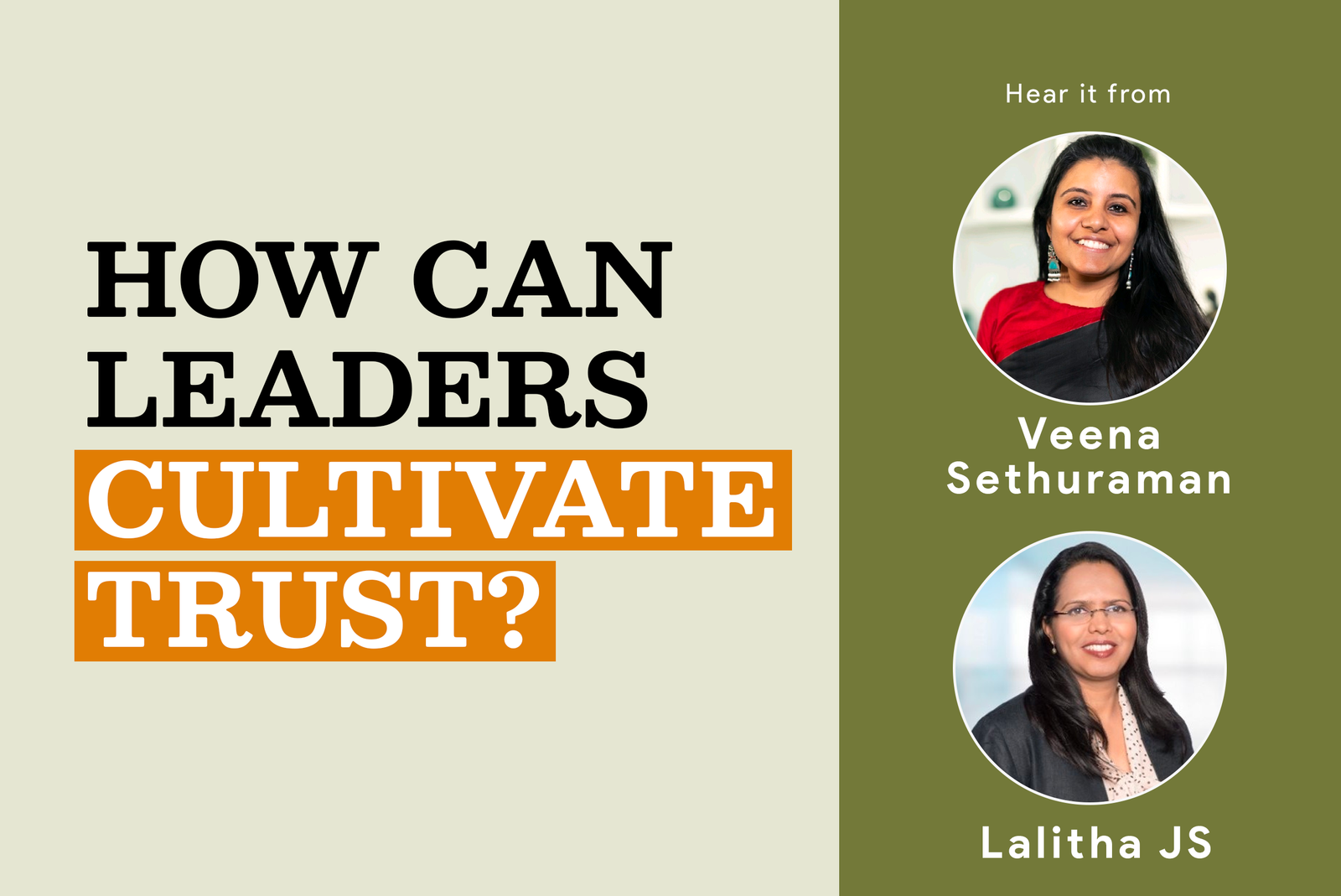
Trust is the unseen fuel for a team’s effective journey together.
No trust = no results.
Leaders who understand this put in efforts to create such an environment. Building trust in the leader and among the members is important to encourage future leaders and promote open communication within the team.
Cultivating trust at all levels of stakeholders is a relational skill that effective leaders work hard for. I invited two leaders to share their thoughts on this question of trust.
Veena (VP & Head, Learning & Organisational Development, Transformational Coach, InMobi):
I have witnessed your growth to an actively incisive person and leader. I am struck by the spontaneity you display in leader conversations. And the comfort with which you hold your identities as leader, coach and therapist. Taking emotional health conversations into organisations was a much-needed move and you do it with passion.
Through your book and social media presence you have touched many, and ignited, and provoked others to embrace their vulnerability.
More power to your authenticity, childlike joy and energy. The world needs more expressive leaders like you.
Lalitha (Senior Director, Consulting Services, Cerner Corporation):
I know you as a leader through associating with you as a client organisation. Your support in the space of women and leadership has been inspiring. I see you as a student for life always exploring, learning, and defining new boundaries to cross. In turbulent times the conversations you initiated with your business teams, focussing on building their capacity for innovation truly impressed me.
You also encouraged potent conversations to build comfort with managing organisational change. You have inspired trust in your teams.
More power to you for bringing the conversation of expansion and growth so powerfully to all who you lead.
Contents
Veena’s approach
I believe trust would need to be cultivated in a consistent way in every conversation with everyone irrespective of whether it already exists or not. Hence, I look at every conversation as a trust building conversation, as it’s easy for the trust to break in a minute.
Here are the few approaches that I use to cultivate trust in workplace:
- Be clear on your intention and others’ intentions. Do not assume. Be courageous enough to ask questions on intentions and purposes as the trust can be built anchoring on these intentions.
- Ask for negative feedback and give the negative feedback openly. Be curious about the reality you are creating in others. It could be your blind spot. Hence, be open to those possibilities.
- At the same time, do not agree passively to all the feedback. Be purposeful in your curiosity to know more about their feedback without carrying the pressure to agree or disagree.
- Give negative feedback without beating around the bush. The intention is to help them grow. Do not carry the pressure to convince them of the feedback you are giving. Create enough autonomy for them to choose what they want to choose as feedback. Also, acknowledge your own mistakes proactively.
- Make it about “us” and “co-creation”. Do not create a veil of separation of “you” vs “me”. Co-create win-win solutions and plans. Depending on the context in which the trust needs to be built, take the initiative to lead, or organize follow-up meetings. Do what you say, and say what you mean.
- Use the word “trust” openly in conversations. Bring the issue of broken trust in the open and resolve it together without stigmatizing the issue.
Lalitha’s approach
Cultivating trust in the workplace takes time and several small actions over many moments. It’s like weaving a delicate net with intricate patterns, yet which is strong enough to provide psychological safety.
What happens when trust breaks down?
The impact of trust breaking down can be quite long lasting. It could take longer to rebuild the trust every time it breaks. Yet, I think as leaders we can do several things to rebuild trust and bring back the team together.
Just like how it’s done in Kintsugi, the Japanese art of putting broken pottery pieces back together with gold – a metaphor for embracing your flaws and imperfections.
When trust breaks down in my teams, first and foremost, I acknowledge the feeling of hurt. I then look at actions to move on. The issues causing the hurt which needs to be addressed more than the feeling of hurt itself.
Here are three scenarios and my approach to each of them:
Scenario 1
Where the team members have lost trust in the team manager:
This scenario is the most serious one. To repair the situation, I have often adopted and suggested (if it’s the case of another manager in my organisation) principles of radical transparency to rebuild the trust. Most team members trust managers who are reliable and hold high integrity, who walk their talk, and who follow through on their promises.
To be trusted by the team, be:
- genuinely interested in team members
- a good listener
- non-judgemental
- a giver of timely acknowledgment
- generous appreciation of achievements
Scenario 2
Where the manager has lost trust in the team members:
In this scenario, my approach as a manager is to quickly overcome the feeling of hurt that my team members have broken my trust and move ahead with kindness. I like to address the root cause as to why they broke the trust in the first place. It is like being a lovingly kind parent.
What works?
I have seen that manager setting clear expectations on what is okay and what is not okay. This helps in building a trust-based relationship with the team members.
Establishing a culture of accountability in the team, where each member owns their mistakes, apologieses, and makes course corrections, goes a long way in establishing trust.
It is helpful to encourage team members to make realistic planning and accurate status updates without any fear of repercussions.
Scenario 3
Where the trust between team members is broken:
When trust breaks in between team members it’s chaos and the manager has a lot to do. It’s important to get a handle on the team dynamics and dig into reasons on why the trust broke.
My Approach:
It is necessary to identify if there are team members not having clear boundaries.
Building a team culture where boundaries are well defined and respected has helped me a lot.
To build the trust between team members, one of the things that I tried was to conduct a HBDI (Herman Brain Dominance Instrument) assessment. This is for the entire team, including myself. This assessment provides a positive and inclusive way to identify the thinking preferences in the team.
This helps avoid non-productive labelling of team members. We learnt to acknowledge and accept the differences, strengths and weaknesses of the team members.
The other ideas for trust building within a team are Informal lunch or get-togethers.
Team games create a sense of community and belonging.
SWOT exercise (Strengths, Weaknesses, Opportunities and Threats) at the team level, brainstorming and letting the team arrive on their own action plans.
In conclusion
The two leaders’ elaborate ideas on trust are so rich.
Trust can be established by one big sweeping move. Trust, also can also be established by hundreds of small steps, actions, and conversations that we leaders take.
To be mindful of boundaries is one of the most useful aspects of managing trust. So also learning to apologise and making amends. It is powerful modelling by a leader.


